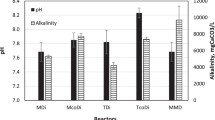Abstract
The wet organic fraction of household wastes was digested anaerobically at 37 °C and 55 °C. At both temperatures the volatile solids loading was increased from 1 g l−1 day−1 to 9.65 g l−1 day−1, by reducing the nominal hydraulic retention time from 93 days to 19 days. The volatile solids removal in the reactors at both temperatures for the same loading rates was in a similar range and was still 65% at 19 days hydraulic retention time. Although more biogas was produced in the thermophilic reactor, the energy conservation in methane was slightly lower, because of a lower methane content, compared to the biogas of the mesophilic reactor. The slightly lower amount of energy conserved in the methane of the thermophilic digester was presumably balanced by the hydrogen that escaped into the gas phase and thus was no longer available for methanogenesis. In the thermophilic process, 1.4 g/l ammonia was released, whereas in the mesophilic process only 1 g/l ammonia was generated, presumably from protein degradation. Inhibition studies of methane production and glucose fermentation revealed a K i (50%) of 3 g/l and 3.7 g/l ammonia (equivalent to 0.22 g/l and 0.28 g/l free NH3) at 37 °C and a K i (50%) of 3.5 g/l and 3.4 g/l ammonia (equivalent to 0.69 g/l and 0.68 g/l free NH3) at 55 °C. This indicated that the thermophilic flora tolerated at least twice as much of free NH3 than the mesophilic flora and, furthermore, that the thermophilic flora was able to degrade more protein. The apparent ammonia concentrations in the mesophilic and in the thermophilic biowaste reactor were low enough not to inhibit glucose fermentation and methane production of either process significantly, but may have been high enough to inhibit protein degradation. The data indicated either that the mesophilic and thermophilic protein degraders revealed a different sensitivity towards free ammonia or that the mesophilic population contained less versatile protein degraders, leaving more protein undegraded.
Similar content being viewed by others
Author information
Authors and Affiliations
Additional information
Received: 26 March 1997 / Received revision: 13 May 1997 / Accepted: 19 May 1997
Rights and permissions
About this article
Cite this article
Gallert, C., Winter, J. Mesophilic and thermophilic anaerobic digestion of source-sorted organic wastes: effect of ammonia on glucose degradation and methane production. Appl Microbiol Biotechnol 48, 405–410 (1997). https://doi.org/10.1007/s002530051071
Issue Date:
DOI: https://doi.org/10.1007/s002530051071




